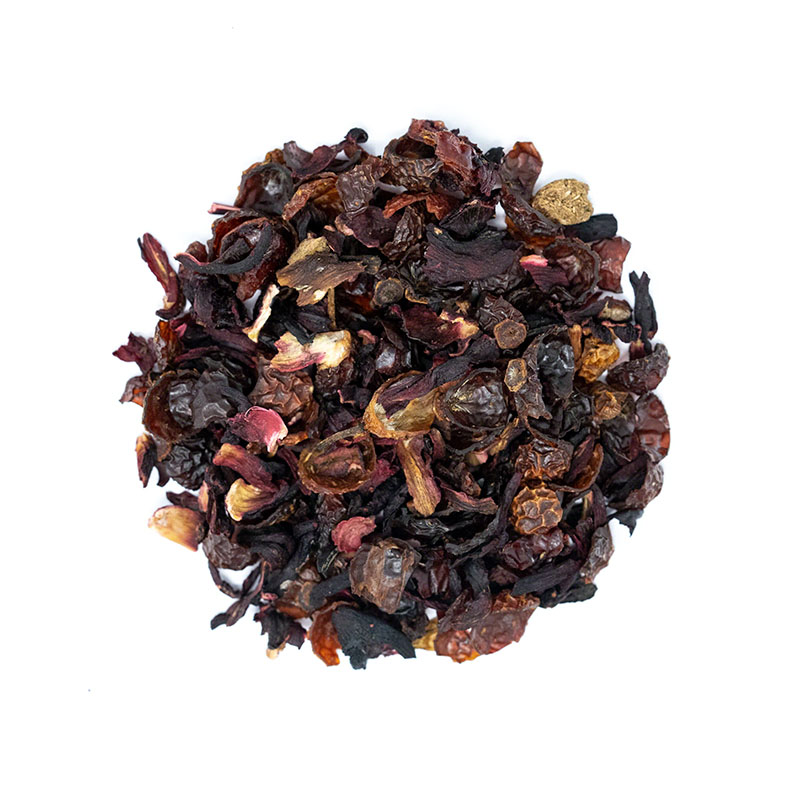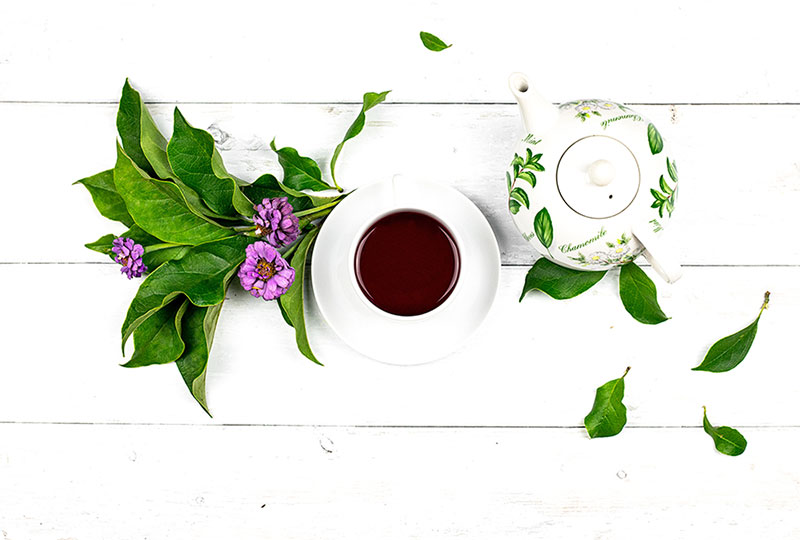Best Elderberry Tea Recipe
Delicious, packed with benefits for cooler months, super easy to make and blend great with many other ingredients – elderberry tea is a must try tea for the upcoming cold season months. Learn how to make your own elderberry flower or fruit tea and what are the potential health benefits of these immune supporting berries and flowers.
What is elderberry?
Elder, Elderberry or Sambucus is a flowering shrub or a little tree found in many countries around the world. Flowers are fruits are used for making a herbal tea, elderberry syrups and jams, liqueurs and flavorings for different sweets. Elderberry tea can be made from two parts of the plant – berries and flowers. Each of them has a very different flavor, color and texture, and may provide health benefits. However, what’s interesting about elderberry is that raw or unripe berries, bark, leaf and seeds may be very poisonous and cause many negative effects[1]. Processed, it’s delicious and widely consumed around the world, and very popular in the northern hemisphere, including North American and Europe. Black elderberries and pale white-yellow flowers have been used in herbal medicine for treating different health problems for hundreds of years.
How to Make Elderberry Tea
You can make elderberry herbal tea from white elderberry flowers or small dark purple berries. The kind of elderberry used for making tea is Sambucus nigra L.. Flowers are available in late spring or early summer, and berries follow after the flowering period. Elderberry and Elderflower tea and caffeine free and may be enjoyed at any time of the day. Both flowers and berries are available in loose form and in tea bags. They are often added to tea blends too.
To make your own elderberry flower tea, collect the flowers during dry sunny days. They shouldn’t be collected after the rain when they are wet. Let them dry for a couple of days. Use only flowers that preserved light yellow color.
To make your own elderberry fruits tea, collect the berries when they are ripe. They should have a dark purple color. Remove any leaves or branches, wash them thoroughly and dry in the oven on low temperature or on dry air. The other name for elderberry flower tea is elderflower tea.
How to Make Elderberry Flower Tea
To make elderberry tea from dried elderberry flowers, use about 3-4 grams of dried flowers per cup of water. Bring water to a boil. Place dried flowers into a teapot and pour hot water. Cover the teapot and let it steep for 10 minutes. Elderberry flower tea tastes delicious with lemon and honey.
To enhance the flavor and add citrusy note, wash one organic lemon and cut it into thin slices. Add the lemon into a teapot together with 1 tablespoon of dried flowers and steep in about 500 ml of water for 10 minutes. Pour into a mug and add a teaspoon of honey.
How to Make Elderberry Fruit Tea
To make elderberry fruit tea use about 1-2 teaspoons of dried berries per cup of water. You can either simmer them ih water over the stove, or steep like a regular tea. Either method will require at least 10-15 minutes. Strain and add sweetener. Just like the elderberry flower tea, elderberry fruit tea taste delicious with some honey.

Cherry T herbal tea with cherries, elderberries and other fruits
What does elderberry tea taste like?
Many people prefer the elderberry flower tea over elderberry fruit tea. This is because of a unique, slightly sweet floral flavor different from other flowery teas. Elderberry fruit tea, on the other hand, has a slightly earthy and tart flavor. It’s light and not overpowering like some other floral teas. It tastes great with ingredients such as lemon, ginger, honey, cinnamon stick or hibiscus.
Benefits of Drinking Elderberry Tea
Both berries and flowers may provide numerous health benefits. They are traditionally used for treating flu and common cold and other respiratory problems such as bronchitis. Benefits may include:
1. Antioxidant activity
Elderberry flowers and berries contain polyphenols and may help boost immune system, reduce oxidative stress and provide numerous benefits. Berries have a dark purple to black color because of anthocyanins, pigments with high antioxidant activity[2]. They also contain vitamin C, vitamin B6 and Vitamin E[3].
2. Treating colds and flu symptoms and bronchitis
Elderberry has antiviral, antifungal and antibacterial properties. Studies showed that elderberry may be helpful in inhibiting infectious bronchitis virus or chicken coronavirus[4].
Furthermore, one research showed that it may be very helpful in treating, but also preventing cold and flu. It may help shorten the duration of cold (for even 4 days[5]) and reduce the severity of symptoms[6]. Elderberries contain a protein that may help to prevent virus to replicate and enter cells if taken before the exposure to viruses.
3. Weight management
Elderberry flower extract may be especially helpful for weight management. Studies showed that it may prevent fat accumulation, decrease body weight and improve BMI[7].
4. Cardiovascular health
Elderberries may be beneficial for preventing heart diseases, stroke and heart attacks Studies showed that they may reduce bad cholesterol, body fat and protect body cells from oxidative stress[8].
Elderberry tea may cause some side-effects and toxicity if consumed raw, unripe, in excessive amounts or from toxic parts of the plant. They include allergic reactions, cyanide poisoning, diarrhea, vomiting, cramps and other health problems[9].
Disclaimer: This article is for informational purposes only. It’s not intended to replace medical advice, diagnosis or treatment. Every person is different and may react to different herbs and teas differently. Never use teas or herbs to treat serious medical conditions on your own. Always seek professional medical advice before choosing home remedies.
References:
[1] https://www.researchgate.net/publication/259696401_An_Evidence-Based_Systematic_Review_of_Elderberry_and_Elderflower_Sambucus_nigra_by_the_Natural_Standard_Research_Collaboration
[2] https://www.sciencedirect.com/science/article/pii/S1756464614002400
[3] https://health.clevelandclinic.org/elderberry-a-natural-way-to-boost-immunity-during-cold-and-flu-season/
[4] https://www.ncbi.nlm.nih.gov/pmc/articles/PMC3899428/
[5] https://health.clevelandclinic.org/elderberry-a-natural-way-to-boost-immunity-during-cold-and-flu-season/
[6] https://www.ncbi.nlm.nih.gov/pmc/articles/PMC4848651/
[7] https://www.sciencedirect.com/science/article/pii/S1756464614002400
[8] https://www.sciencedirect.com/science/article/pii/S1756464614002400
[9] https://www.researchgate.net/publication/259696401_An_Evidence-Based_Systematic_Review_of_Elderberry_and_Elderflower_Sambucus_nigra_by_the_Natural_Standard_Research_Collaboration





